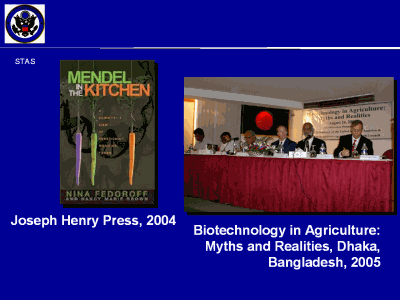| front |1 |2 |3 |4 |5 |6 |7 |8 |9 |10 |11 |12 |13 |14 |15 |16 |17 |18 |19 |20 |21 |22 |23 |24 |25 |26 |27 |28 |29 |30 |31 |32 |33 |34 |review |
 |
Whether it is water for people or water for agriculture, land for food or land for biofuels, we are rapidly approaching the limits of what our planet can support. The only alternative to fighting over water is working together to distribute it fairly and utilize it in increasingly efficient ways through science and technology. The only alternative to higher food prices and progressive deforestation is to use contemporary science, including molecular modification, to increase the productivity of the land we already farm and decrease its water demands. Problem-solving is best, of course, when the most up-to-date knowledge and technology are part of the solution. And in this context, there is plenty of room for both science and diplomacy. Those of you who, like me, have engaged in some of the idealogical battles over contemporary genetic modification of crop plants know that it takes much more than just the facts to change peoples’ minds and attitudes. My own appreciation of the importance of science diplomacy deepened after I wrote a book on GMOs in which I sought to explain the science behind the contemporary molecular modification of crop plants. Shortly after it was published in 2004, I received an email from a Foreign Service Officer in the American Embassy in Dhaka, Bangladesh asking me to come and speak about GMOs. Bangladesh is a poor country with a small area of arable land, often submerged by flood waters. Government officials found the differences in attitude between Europe and the U. S. confusing and had not developed a policy toward GM crops. Our embassy invited several speakers to address the scientific basis of GM crops and speak about both the real – and the perceived – risks that they posed. *The conference was attended by government officials, scientists, diplomats and the press. It opened channels of communication between scientists in Bangladesh and scientists in the US and Europe. As well, it opened discussions between scientists, reporters and politicians – an immensely important dialog in moving forward with a controversial technology. |